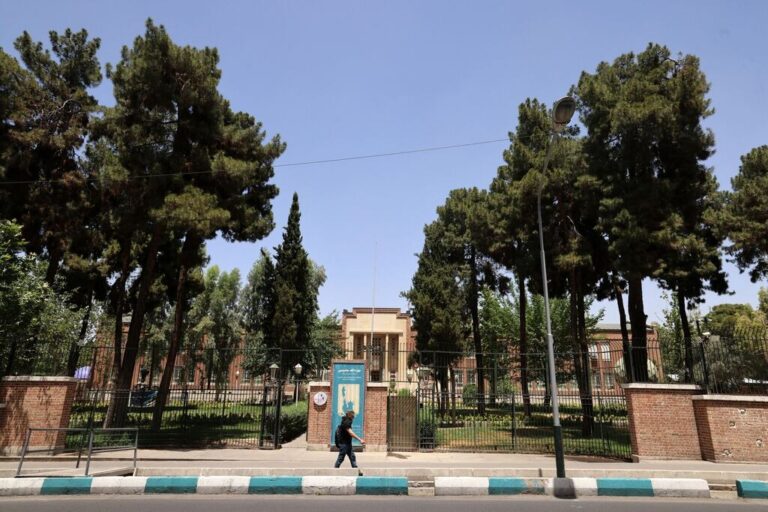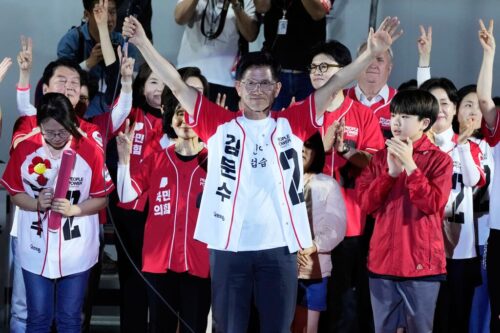The Trump administration is proposing an arrangement that would allow Iran to continue enriching uranium at low levels while the United States and other countries work out a more detailed plan intended to block Iran’s path to a nuclear weapon but give it access to fuel for new nuclear power plants.
The proposal amounts to a bridge between the current situation, in which Iran is rapidly producing near-bomb-grade uranium, and the U.S. goal of Iran enriching no uranium at all on its soil.
Under the proposal, the United States would facilitate the building of nuclear power reactors for Iran and negotiate the construction of enrichment facilities managed by a consortium of regional countries. Once Iran began receiving any benefits from those promises, it would have to stop all enrichment in the country.
The outline of the potential deal, which was described on the condition of anonymity by Iranian and European officials, was handed to Iran over the weekend. Officials in Tehran indicated Monday that a response would come in several days.
It is the first concrete indication since President Donald Trump took office that the United States and Iran might be able to find a path to compromise that would head off a potential regional war over Tehran’s ambitions to build a nuclear weapon.
But the details remain vague, the two sides remain far apart on many elements of a deal, and the domestic politics for both are complex. In his first term, Trump canceled an agreement negotiated under President Barack Obama that had similarly sought to keep Iran from being able to produce a nuclear bomb.
At least in the opening years of the proposed arrangement, when new enrichment facilities to produce fuel for power plants are being built in cooperation with Arab states, Iran would be allowed to continue enriching uranium at low levels, despite Trump’s post on social media Monday saying the United States would “not allow any enrichment of uranium.” (It is possible that he was referring to what would be allowed at the concluding stage of the potential deal rather than during an interim arrangement.)
The idea of a regional consortium would essentially wrap Iran in a bearhug with countries that might include the United States, Saudi Arabia, the United Arab Emirates and others, allowing the production of low-grade nuclear fuel for power plants while seeking to ensure that Iran is not enriching fuel on its own for a bomb.
But one key unresolved question is whether Iran’s leadership will agree to an ultimate arrangement in which no nuclear fuel is produced on Iranian soil. “We do not need anyone’s permission to enrich uranium,” Iran’s foreign minister, Abbas Araghchi, said Tuesday.
Israel has also been deeply skeptical of any deal that would leave Iran with nuclear capabilities. It has repeatedly suggested that now is the time for a military strike on Iranian nuclear facilities, citing Tehran’s degraded air defense systems and the weakness of its regional allies Hamas and Hezbollah.
Iran, however, still possesses a formidable arsenal of conventional weapons, including ballistic missiles, capable of threatening Israel, Gulf neighbors and U.S. bases in the region.
Iranian officials have warned that in the event of a military strike on their nuclear facilities, they would respond forcefully, exit the nonproliferation agreement and end international inspectors’ access to sites.
The wording of the new proposal, crafted by Steve Witkoff, Trump’s special envoy to the Middle East, is vaguely worded on many of the most important issues, suggesting that considerable negotiating lies ahead, Iranian and European officials said.
For example, it is unclear that the accord meets the standard Trump said last week that he would demand, an agreement in which “we can take whatever we want; we can blow up whatever we want.” Senior Iranian officials involved in the negotiations called the bombastic statement “a fantasy.”
Araghchi said Monday at the sideline of meetings in Egypt with officials that Iran would “soon send America an appropriate response. Without respecting our right to enrich uranium, there will be no agreement.”
He added that he was confident of a diplomatic breakthrough to avert further crises.
The Trump administration’s proposal, according to two Iranian officials, leaves unclear exactly what would be required in dismantling the country’s nuclear program.
Iran has invested billions of dollars in building its two main nuclear facilities, Natanz and Fordo, and in developing its advanced nuclear program, which it considers a source of national pride. Shuttering the facilities would be humiliating and difficult to justify, according to an Iranian official familiar with the internal deliberations.
These facilities also employ hundreds of scientists, some of the country’s most talented, and the government worries that many of the top ones may leave Iran if they are unemployed and waiting for the new consortium to take shape, an Iranian official said. Over the years, Israel has targeted and assassinated a number of leading nuclear scientists, including Mohsen Fakhrizadeh.
The proposal did not specify which of the hundreds of sanctions against Iran would be removed in any final deal. Iran has told the United States that all sanctions would need to be removed in order to sign a deal — not just those related to its nuclear program.
Iranian officials said they would not take any measures curbing their program without parallel sanctions relief, particularly diluting or exporting the huge stockpile of enriched uranium that the United Nations’ atomic watchdog says would allow them to build 10 bombs if they chose to weaponize.
While the outcome of the negotiation remains unclear, Witkoff’s strategy is beginning to emerge.
The consortium he proposed would provide nuclear fuel for Iran and any of its neighbors interested in developing civilian nuclear power or research programs. The many players would watch one another — and they would be watched by the International Atomic Energy Agency, the U.N. group that monitors nuclear fuel around the world and is supposed to send alarms if it believes the fuel is being diverted to a weapons program.
But the proposal does not make clear exactly where the enrichment facility would be located, though the U.S. has said it cannot be in Iran. Iranian officials continue to insist it must be in their territory, because they would not give up their right to enrich nuclear fuel under the Nuclear Nonproliferation Treaty.
Iran is a signatory to the treaty, though so far it has not ratified an addendum, called the Additional Protocol, that would give inspectors much greater rights to search any part of the country where they suspect nuclear activity.
Although it was not noted in the U.S. proposal, Omani and Saudi officials have discussed the idea of building an enrichment facility on an island in the Persian Gulf. This would potentially give both sides a talking point: The Iranians would be able to say they are still enriching uranium, and the Americans could state that enrichment is not happening on Iranian soil.
Two Iranian officials said the country was open to accepting the consortium idea because the government did not want talks to fail. But the Iranian officials said negotiators planned to bargain in the next round of talks for the island to be one of their own: They may propose Kish or Qeshm in the Persian Gulf, though other possibilities have been discussed.
Iran claims these territories and would most likely argue that this would allow it to keep enrichment on its soil. But it would also make a facility much more visible to the world than Iran’s current enrichment facilities, which are underground, and in one case deep inside a mountain to protect against Israeli attack.
This article originally appeared in The New York Times.
Iran has amassed even more near weapons-grade uranium, UN watchdog saysWhat to know about the tensions between Iran and the US before their fifth round of nuclear talksAs Trump seeks Iran deal, Israel again raises possible strikes on nuclear sites



